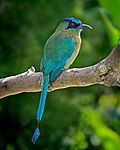| Momotus | |
|---|---|
 | |
| Trinidad motmot (Momotus bahamensis) | |
| Scientific classification | |
| Kingdom: | Animalia |
| Phylum: | Chordata |
| Class: | Aves |
| Order: | Coraciiformes |
| Family: | Momotidae |
| Genus: | Momotus Brisson, 1760 |
| Type species | |
| Ramphastos momota Linnaeus, 1766 | |
| Species | |
see text | |
Momotus is a small genus of the motmots, a family of near passerine birds found in forest and woodland of the Neotropics. They have a colourful plumage, which is green on the back becoming blue on the flight feathers and the long tails. The barbs near the ends of the two longest central tail feathers fall off, leaving a length of bare shaft so that tails appear racket-shaped.
Contents
Momotus species, like other motmots, eat small prey such as insects and lizards, and will also take fruit. They nest in tunnels in banks, laying about four white eggs.
The genus Momotus was introduced by the French zoologist Mathurin Jacques Brisson in 1760 with the Amazonian motmot (Momotus momota) as the type species. [1] [2]














